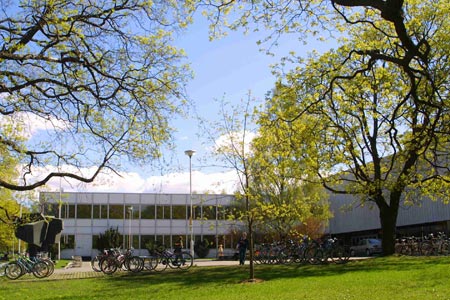 May 12-16, 2014
May 12-16, 2014
University of Tampere
On May 12-16, 2014 Rector of our University had an educational visit to the University of Tampere in the frame of Tempus project "Education for Leadership, Intelligence and Talent Encouraging".
First of all we would like to say a few words about Tampere. Tampere (Swedish: Tammerfors) is the third largest city in Finland. Being located 170km north of the Finnish coastal capital Helsinki, it is also the biggest inland town in the whole Nordic region. Despite being predominantly a former heavy industry centre, today Tampere is a major hub for information technology, research, education, culture, sports and business. In 2010, the City of Tampere came in first in an image survey comparing the largest cities in Finland.
There are three higher educational institutions in Tampere: Tampere University of Applied Sciences (TAMK), the School of Vocational Teacher Education is part of TAMK, Tampere University of Technology and the University of Tampere http://www.uta.fi/english/index.html .
The University of Tampere is a culturally-committed higher education institution with the social mission of educating visionaries who understand the world and change it. What is now the University of Tampere began in 1925 in Helsinki as an institution generally referred to as a Civic College. In the 1960s the institution moved to Tampere. Today it has nine schools and 16 000 students. The University had 18 659 applicants in 2013 and only 2130 students secured the place to study.
There are 14 Classical Universities and 24 Applied Technical Universities in Finland. There are totally 300 000 students in Finland. 170 000 students and 185 000 PhDs study in the universities. Nearly 60-70% of school graduators become students of the higher educational institutions. It is a well known fact that Finland secondary school system of education is one of the best in the world.
System of education is free. Students are supported by means of scholarships. Students can study seven years for getting a Bachelor degree and only two of them will be not financed (scholarship). Students have 50% discount on food in the University canteen. So, student has to pay only 3-4 € per lunch. Finland spends 6% of GDP on education and holds the third place in the world after Norway and Denmark (8%).
Universities do not depend on the Ministry of Education and Culture, but the Ministry monitors universities and their achievements for measuring further finance support.
Each University has its own quality assurance system based on the principle of educational audit. It stimulates its development. University is responsible for the quality of knowledge. Once per six years University has to pass the accreditation, but the result is just the matter of reputation. The government does not impose sanctions on the University.
European Association of Universities has imposed the indicators of autonomy. Finland has the following indicators: organizational autonomy – third position, finance autonomy – fifteenth position and academic autonomy – fifth position.
The model of finance support is 75% and it is oriented on the result. 41% is on education and 34% is on research. In case when the University has got the finance support from the EU, the country adds 9%. When the University has international academics and researchers the government adds 2% nand for publications – 3%. Students and their opinion are also very important for the government. In order to determine the quality of educational institutions was implemented the National Questionnaire for students.
Universities started their reformation in 2010.They have faced lot of challenges:
- widening of the University autonomy;
- universities are governmental, but they do not depend on the government;
- academics are hired employees;
- University Council consists of 60 staff members and 40 external;
It is a very interesting fact that two private universities are financed by the government. Nowadays, rectors are elected by the University Council. It is not appropriate for the University to duplicate curriculums. Each of them has to implement their own curriculums.
In addition we would like to say that teaching is a very prestigious occupation in Finland. Only those who have Master degree can work at school. At the same time Bachelor degree is not so popular among employers. The same tendencies we have in Ukraine. The only thing we need to do is to make teaching a prestigious profession.
